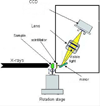A review of non-invasive imaging methods and applications in contaminant hydrogeology research
- PMID: 20163885
- PMCID: PMC3864598
- DOI: 10.1016/j.jconhyd.2010.01.001
A review of non-invasive imaging methods and applications in contaminant hydrogeology research
Abstract
Contaminant hydrogeological processes occurring in porous media are typically not amenable to direct observation. As a result, indirect measurements (e.g., contaminant breakthrough at a fixed location) are often used to infer processes occurring at different scales, locations, or times. To overcome this limitation, non-invasive imaging methods are increasingly being used in contaminant hydrogeology research. Four of the most common methods, and the subjects of this review, are optical imaging using UV or visible light, dual-energy gamma radiation, X-ray microtomography, and magnetic resonance imaging (MRI). Non-invasive imaging techniques have provided valuable insights into a variety of complex systems and processes, including porous media characterization, multiphase fluid distribution, fluid flow, solute transport and mixing, colloidal transport and deposition, and reactions. In this paper we review the theory underlying these methods, applications of these methods to contaminant hydrogeology research, and methods' advantages and disadvantages. As expected, there is no perfect method or tool for non-invasive imaging. However, optical methods generally present the least expensive and easiest options for imaging fluid distribution, solute and fluid flow, colloid transport, and reactions in artificial two-dimensional (2D) porous media. Gamma radiation methods present the best opportunity for characterization of fluid distributions in 2D at the Darcy scale. X-ray methods present the highest resolution and flexibility for three-dimensional (3D) natural porous media characterization, and 3D characterization of fluid distributions in natural porous media. And MRI presents the best option for 3D characterization of fluid distribution, fluid flow, colloid transport, and reaction in artificial porous media. Obvious deficiencies ripe for method development are the ability to image transient processes such as fluid flow and colloid transport in natural porous media in three dimensions, the ability to image many reactions of environmental interest in artificial and natural porous media, and the ability to image selected processes over a range of scales in artificial and natural porous media.
2010. Published by Elsevier B.V.
Figures








Similar articles
-
Review of Microfluidic Devices and Imaging Techniques for Fluid Flow Study in Porous Geomaterials.Sensors (Basel). 2020 Jul 20;20(14):4030. doi: 10.3390/s20144030. Sensors (Basel). 2020. PMID: 32698501 Free PMC article. Review.
-
Optimizing pink-beam fast X-ray microtomography for multiphase flow in 3D porous media.J Microsc. 2020 Feb;277(2):100-106. doi: 10.1111/jmi.12872. Epub 2020 Feb 13. J Microsc. 2020. PMID: 32022271
-
Identification of sampling patterns for high-resolution compressed sensing MRI of porous materials: 'learning' from X-ray microcomputed tomography data.J Microsc. 2019 Nov;276(2):63-81. doi: 10.1111/jmi.12837. Epub 2019 Nov 6. J Microsc. 2019. PMID: 31587277
-
Direct characterization of solute transport in unsaturated porous media using fast X-ray synchrotron microtomography.Proc Natl Acad Sci U S A. 2020 Sep 22;117(38):23443-23449. doi: 10.1073/pnas.2011716117. Epub 2020 Sep 8. Proc Natl Acad Sci U S A. 2020. PMID: 32900944 Free PMC article.
-
Review on subsurface colloids and colloid-associated contaminant transport in saturated porous media.Adv Colloid Interface Sci. 2006 Feb 28;119(2-3):71-96. doi: 10.1016/j.cis.2005.09.001. Epub 2005 Dec 1. Adv Colloid Interface Sci. 2006. PMID: 16324681 Review.
Cited by
-
Image analysis procedure for studying Back-Diffusion phenomena from low-permeability layers in laboratory tests.Sci Rep. 2016 Jul 28;6:30400. doi: 10.1038/srep30400. Sci Rep. 2016. PMID: 27465129 Free PMC article.
-
Visualization of Interstitial Pore Fluid Flow.J Imaging. 2022 Jan 30;8(2):32. doi: 10.3390/jimaging8020032. J Imaging. 2022. PMID: 35200734 Free PMC article.
-
Real-time gamma imaging of technetium transport through natural and engineered porous materials for radioactive waste disposal.Environ Sci Technol. 2013 Dec 3;47(23):13857-64. doi: 10.1021/es402718j. Epub 2013 Nov 12. Environ Sci Technol. 2013. PMID: 24147650 Free PMC article.
-
Review of Microfluidic Devices and Imaging Techniques for Fluid Flow Study in Porous Geomaterials.Sensors (Basel). 2020 Jul 20;20(14):4030. doi: 10.3390/s20144030. Sensors (Basel). 2020. PMID: 32698501 Free PMC article. Review.
-
Novel fluid-fluid interface domains in geologic media.Environ Sci Process Impacts. 2019 Jan 23;21(1):145-154. doi: 10.1039/c8em00343b. Environ Sci Process Impacts. 2019. PMID: 30542687 Free PMC article.
References
-
- Al-Kharusi AS, Blunt MJ. Network extraction from sandstone and carbonate pore space images. J. Petrol. Sci. Engineer. 2007;56(4):219–231.
-
- Al-Raoush RI, Willson CS. Extraction of physically realistic pore network properties from three-dimensional synchrotron X-ray microtomography images of unconsolidated porous media systems. J. Hydrol. 2005a;300(1–4):44–64.
-
- Al-Raoush RI, Willson CS. A pore-scale investigation of a multiphase porous media system. J. Contam. Hydrol. 2005b;77:67–89. - PubMed
-
- Altman SJ, Rivers ML, Reno M, Cygan RT, Mclain AA. Characterization of Adsorption Sites on Aggregate Soil Samples Using Synchrotron X-Ray Computerized Microtomography. Environ. Sci. Technol. 2005;39:2679–2685. - PubMed
-
- Amin MHG, Chorely RJ, Richards KS, Hall LD, Carpenter TA, Cislerova M, Vogel T. Study of infiltration into a heterogeneous soil using magnetic resonance imaging. Hydrolog. Proc. 1997;11(5):471–483.
Publication types
MeSH terms
Substances
Grants and funding
LinkOut - more resources
Full Text Sources
Research Materials

